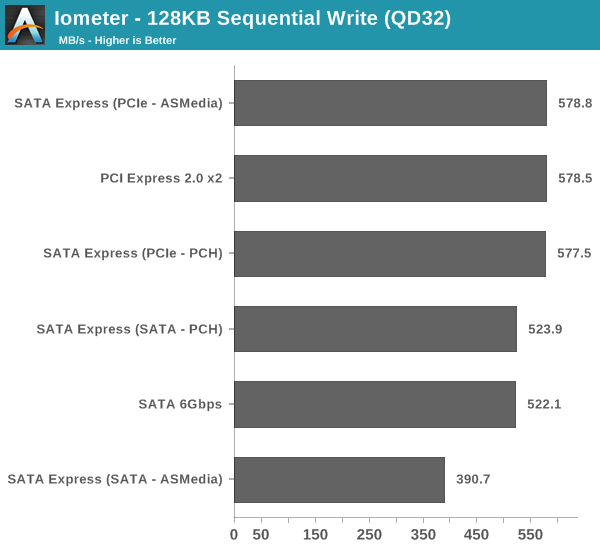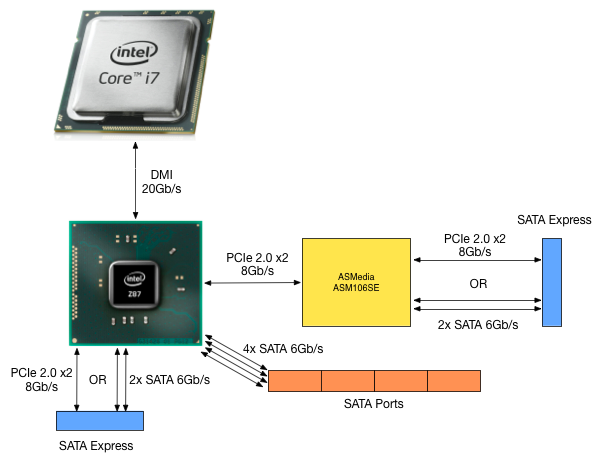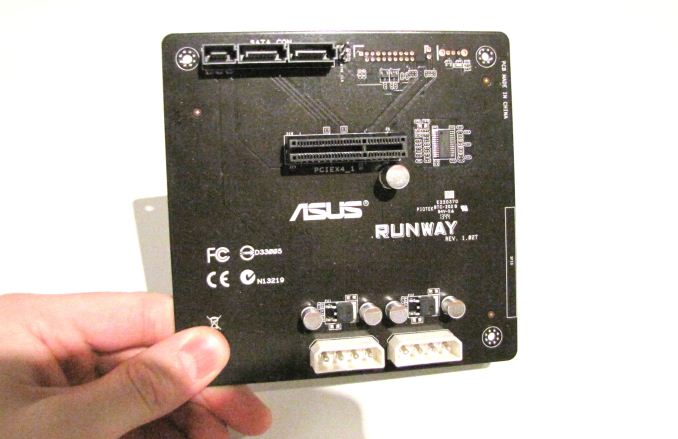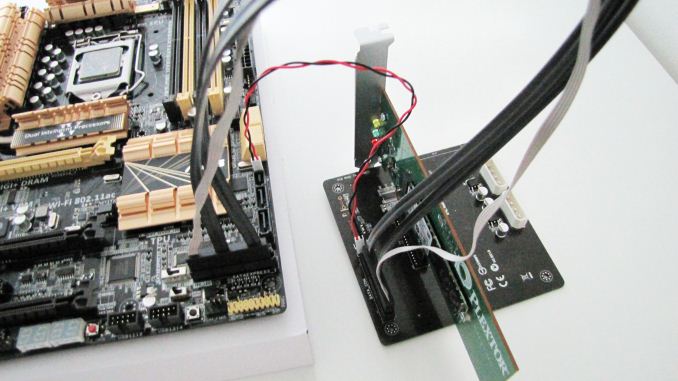Testing SATA Express And Why We Need Faster SSDs
by Kristian Vättö on March 13, 2014 7:00 AM EST- Posted in
- Storage
- SSDs
- Asus
- SATA
- SATA Express
Testing SATA Express
SATAe is not commercially available yet but ASUS sent us a pre-production unit of the SATA Express version of their Z87 Deluxe motherboard along with the necessary peripherals to test SATAe. This is actually the same motherboard as our 2014 SSD testbed but with added SATAe functionality.
| Test Setup | |
| CPU | Intel Core i7-4770K at 3.5GHz (Turbo & EIST enabled, C-states disabled) |
| Motherboard | ASUS Z87 Deluxe SATA Express (BIOS 1707) |
| Chipset | Intel Z87 |
| Chipset Drivers | 9.4.0.1026 |
| Storage Drivers | Intel RST 12.9.0.1001 |
| Memory | Corsair Vengeance DDR3-1866 2x8GB (9-10-9-27 2T) |
| Graphics | Intel HD Graphics 4600 |
| Graphics Drivers | 15.33.8.64.3345 |
| Power Supply | Corsair RM750 |
| OS | Windows 7 Ultimate 64-bit |
Before we get into the actual tests, we would like to thank the following companies for helping us with our 2014 SSD testbed.
- Thanks to Intel for the Core i7-4770K CPU
- Thanks to ASUS for the Z87 Deluxe motherboard
- Thanks to Corsair for the Vengeance 16GB DDR3-1866 DRAM kit, RM750 power supply, Hydro H60 CPU cooler and Carbide 330R case
The ASUS Z87 Deluxe SATA Express has two SATAe ports: one routed from the Platform Controller Hub (PCH) and the other provided by an ASMedia ASM106SE chip. The ASMedia is an unreleased chip, hence there is no information to be found about it and ASUS is very tight-lipped about the whole thing. I'm guessing we are dealing with the same SATA 6Gbps design as other ASM106x chips but with added PCIe pass-through functionality to make the chip suitable for SATA Express.
I did a quick block diagram that shows the storage side of the ASUS SATAe board we have. Basically there are four lanes in total dedicated to SATAe with support for up to two SATAe drives in addition to four SATA 6Gbps devices. Alternatively you can have up to eight SATA 6Gbps devices if neither of the SATAe ports is operating in PCIe mode.
Since there are no SATAe drives available at this point, ASUS sent us a SATAe demo daughterboard along with the motherboard. The daughterboard itself is very simple: it has the same SATAe connector as found in the motherboard, two molex power inputs, a clock cable header, and a PCIe slot.
This is what the setup looks like in action (though as you can see, I took the motherboard out of the case since inside case photos didn't turn out so well with the poor camera I have). The black and red cable is the external clock cable, which is only temporary and won't be needed with a final SATAe board.
The Tests
For testing I used Plextor's 256GB M6e PCIe SSD, which is a PCIe 2.0 x2 SSD with Marvell's new 88SS9183 PCIe controller. Plextor rates the M6e at up to 770MB/s read and 580MB/s write, so we should be capable of reaching the full potential of PCIe 2.0 x2. Additionally I tested the SATA 6Gbps ports with a 256GB OCZ Vertex 450. I used the same sequential 128KB Iometer tests that we use in our SSD reviews but I ramped up the queue depth to 32 to make sure we are looking at a maximum throughput situation.

There is no practical difference between a PCIe slot on the motherboard and PCIe that is routed through SATA Express. I'm a little surprised that there is absolutely no hit in performance (other than a negligible 1.5MB/s that's basically within the margin of error) because after all we are using cabling that should add latency. It seems that SATA-IO has been able to make the cabling efficient enough to transmit PCIe without additional overhead.
As for SATA 6Gbps, the performance is the same as well, which isn't surprising since only the connector is slightly different while electrically everything is the same. With the ASMedia chipset there is ~25-27% reduction in performance but that is inline with the previous ASMedia SATA 6Gbps chipsets I've seen. As I mentioned earlier, I doubt that the ASM106SE brings anything new to the SATA side of the controller and that's why I wasn't expecting more than 400MB/s. Generally you'll only get full SATA bandwidth from an Intel chipset or a higher-end SATA/RAID card.

The same goes for write performance. The only case where you are going to see a difference is if you connect to the ASMedia SATA 6Gbps port. I did run some additional benchmarks (like our performance consistency test) to see if a different workload would yield different results but all my tests showed that SATAe in PCIe mode is as fast as a real PCIe slot, so I'm not going to post a bunch additional graphs showing that the two are equivalent.













131 Comments
View All Comments
phoenix_rizzen - Friday, March 14, 2014 - link
I was thinking more for the situation where you replace the current SATA ports on a mobo with PCIe x2 slots.So you go from cabling your drives to the SATA ports to cabling your drives to the PCIe ports. Without using up any of the slots on the back of the board/case.
SirKnobsworth - Saturday, March 15, 2014 - link
If you don't want to use actual PCIe slots then have M.2 sockets on the motherboard. There's no reason to have another cabling standard.phoenix_rizzen - Monday, March 17, 2014 - link
That works too, and is something I mention in another comment above.This cable and connector doesn't make sense, any way you look at it.
Kracer - Thursday, March 13, 2014 - link
Are you able to run any sort of PCI-Device over SATAe (GPUs, capture cards, etc.)?Two lanes are not enough for GPU use but it would open up much more possibilities.
Are you able to use it as a boot device?
The Von Matrices - Thursday, March 13, 2014 - link
I understand the desire for faster SSDs, but I still fail to see the purpose of SATA express over competing standards. There's nothing compelling about it over the competition.M.2 already provides the PCIe x2 interface and bandwidth (albeit without the ability to use cables).
Motherboards that support PCIe 3.0 SATA Express without either a high priced PCIe switch or compromising discrete graphics functionality are one to two years away.
SF3700 is PCIe 2.0 x4, meaning that SATA express can only use half its performance and PCIe x4 cards will still be the enthusiast solution.
NVMe can already be implemented on other standards.
The cables are bulky, which is unusual considering that SAS at 12Gb/s (which is available) is using the same small connectors as 6Gb/s.
SirKnobsworth - Thursday, March 13, 2014 - link
M.2 provides a PCIe x4 interface in certain configurations. I think the SATAe specification has the provision for adding another two lanes at some point in the future but that's not going to happen for a long time.Kevin G - Thursday, March 13, 2014 - link
SATAe and NVMe is fast and important for expandable IO. However I believe that it will be secondary over the long term. I fathom that the NAND controller will simply move on-die for mobile SoCs. The reason for this will be power savings, lower physical area and performance reasons. Some of the NVMe software stack will be used here but things like lane limitations will be entirely by-passed since it all on die. Bandwidth would scale by the number of NAND channels. Power savings will come from a reduction in an external component (SATAe controller and/or external chipset) and the ability to integrate with the SoC's native power management controller. Desktop versions of these chips will put the NAND on a DIMM form factor for expansion.The SATAe + NVMe will be huge in the server market though. Here RAS plays a bigger role. Features like redundancy and hotswap are important, even with more reliable SSD's compared to their hard drive predecessors. I eventually see a backplane version of a connector like mSATA or M.2 replacing 2.5" hard drives/SSD in servers. This would be great for 1U servers as they would no longer be limited to 10 drives. The depth required on a 1U server wouldn't be as much either. PCIe NVMe cards will fill the same niche today: radically high storage bandwidth at minimal latencies.
One other thing worth pointing out is that since Thunderbolt encapsulates PCIe, using external SATAe storage at full speed becomes a possibility. Working in NVMe mode is conceptually possible over Thunderbolt too.
xdrol - Thursday, March 13, 2014 - link
Parallel ATA is back, just look at the cable size..JDG1980 - Thursday, March 13, 2014 - link
A ribbon cable *plus* a Molex? Oh, goody. This looks like a massive step backward.sheh - Thursday, March 13, 2014 - link
Who doesn't love them flatcables?